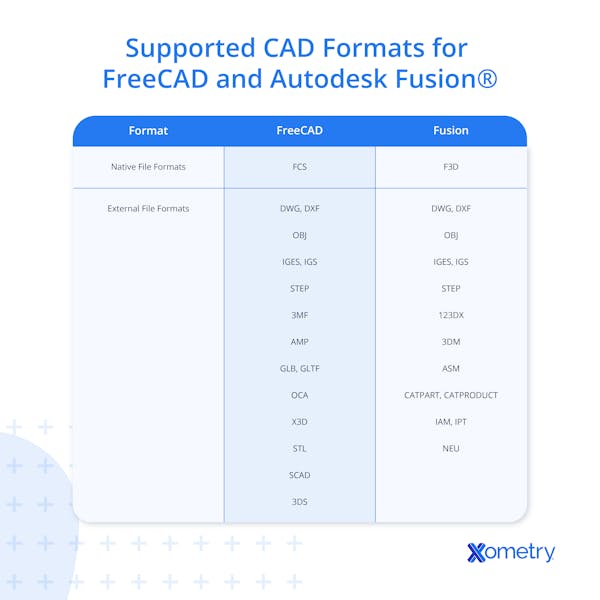When you’re 3D printing, whether for mass production or prototyping, the software you use is arguably the most important factor in the whole process and can make or break your project. Two of the most common 3D software options are FreeCAD and Fusion 360, which we’ll look at in more detail in this article. Read on to find out which one is the best for your needs.
What is FreeCAD?
FreeCAD is a completely free and open-source computer-aided design (CAD) package—its source code is available under an LGPL-2.0 License which means it is free even for commercial use. It’s used to make parametric 3D models (those with dimensions that can be changed without having to redraw the entire model each time). FreeCAD’s open-source nature allows users to access and modify its source code, enabling customizations not possible with most commercial CAD tools. It has a computer-aided engineering (CAE) component that can be used to simulate how a part reacts to a load. It also has an experimental computational fluid dynamics (CFD) module, as well as some limited computer-aided manufacturing (CAM) functionality for preparing parts for CNC machining.
FreeCAD’s powerful 3D modeling workspace can compete with many commercial CAD packages, but it does have a steep learning curve and lacks formal technical support because of its community-driven nature (it’s not backed by a tech company). The software is continuously being improved and developed, which may come at the cost of some application stability—nothing new when it comes to open-source software packages. While it works with most open CAD formats, it doesn’t support a number of proprietary formats.
What is Fusion 360?
Fusion 360 is a cloud-connected engineering tool developed by Autodesk with an excellent set of features that assist engineers throughout the entire lifecycle of product development. It has a robust collaborative function that allows teams to work on projects without having to be in the same location. Like FreeCAD, Fusion 360 is also a parametric-style 3D modeling package. It has a wide range of features that include standard 3D modeling, and a very capable CAE module that includes features like FEA (Finite Element Analysis), mold analysis, motion analysis, and generative design. Fusion 360 also has an excellent CAM module that is regularly updated. This software runs more of its processor-intensive functions, such as simulation and rendering, in the cloud. This results in a significantly faster turnaround time to generate an output when making use of these computationally intensive functions.
Fusion 360 is easier to learn compared to FreeCAD, has a modern user interface, can import a wide range of proprietary file formats, and has a large, active user community. Multiple subscription models are also available at different price points. However, the pricing can get complicated, as Fusion 360 makes use of a token system to access some of its more advanced CAE and CAM features. For example, some types of FEA simulations will require more tokens to run and therefore cost more money. Fusion 360 does have free versions, but these have relatively limited capabilities when compared to the paid versions.
FreeCAD vs. Fusion 360 — Use Cases and Applications
FreeCAD has many of the modeling features found in premium CAD packages. It is primarily used for mechanical engineering and product design tasks and is used extensively for designing mechanical components and assemblies. Similarly, Fusion 360 is widely used in product design but offers a more polished user experience with built-in cloud collaboration. While both tools support assemblies, neither can manage large, complex assemblies like Solidworks or Autodesk Inventor. If projects aren’t too complicated, FreeCAD can assist engineers with all of the tasks required throughout a product's complete lifecycle, from initial modeling, through simulation using an FEA (Finite Element Analysis) solver, to manufacturing simulation and control using its CAM package. Fusion 360 offers an integrated and polished solution for design, simulation (FEA, generative design), and CAM, with cloud-based processing that can outpace FreeCAD in efficiency.
FreeCAD also has a powerful architectural modeling toolkit that makes it relatively easy to create architectural plans and can be used to create photorealistic renderings for marketing purposes. Fusion 360 does not include specialized architectural tools and focuses primarily on product design and engineering applications. For architectural needs, Autodesk provides other tailored solutions suggesting that Fusion 360 is not designed for this domain.
FreeCAD vs. Fusion 360 — System Requirements
FreeCAD and Fusion 360 have a smaller footprint when compared to more feature-rich CAD packages like the already mentioned Solidworks and Autodesk Inventor. On one hand, FreeCAD can be run on almost any hardware, provided the GPU supports OpenGL (a programming interface used in rendering 2D and 3D vector graphics). On the other hand, performance may be limited when handling complex models on lower-end systems. For comparison, Fusion 360 cannot be run on lower-end systems. Table 1 indicates the recommended system requirements for Fusion 360 and FreeCAD:
| Requirement | FreeCAD | Fusion 360 |
|---|---|---|
Requirement Operating system | FreeCAD Windows 8 (or newer), macOS, Linux 10.13 High Sierra or newer, Linux | Fusion 360 Windows 10 or newer, macOS 13 Ventura or newer |
Requirement Processor | FreeCAD 64 Bit Processor (multi-core recommended) | Fusion 360 x86-64 processor
2 performance cores, 4 threads
3GHz+ turbo clock rate (Windows)
1.4GHz dual-core Intel Core i5 processor or Apple silicon M1 chip (macOS) |
Requirement Memory (RAM) | FreeCAD > 4 GB (as models become larger and more complex, it’s a good idea to upgrade to 8 GB) | Fusion 360 > 8 GB (minimum of 4 GB, but at least 8 GB for larger and more complex models will be a smoother experience) |
Requirement Display card | FreeCAD Compatible with OpenGL | Fusion 360 1GB Memory - Dedicated/Integrated Graphics - DirectX11 (Windows)
1.4GHz dual-core Intel Core i5 processor or Apple silicon M1 chip (macOS) |
Requirement Disk space | FreeCAD > 1GB | Fusion 360 > 8.5 GB |
Requirement Internet | FreeCAD n/a | Fusion 360 5 Mbps download; 1 Mbps upload |
FreeCAD vs. Fusion 360 — System Requirements

| Factor | FreeCAD | Fusion 360 |
|---|---|---|
Factor Price | FreeCAD Completely free to use and modify | Fusion 360 Monthly plan: $85
Annual plan: $680
3-year plan: $2,040
Token system with various pricing for advanced CAE and CAM features |
Factor Learning curve | FreeCAD Quite steep, not very intuitive, some tools are difficult to locate | Fusion 360 Fairly easy, with built-in tutorials |
Factor User experience | FreeCAD A dated user interface, not as polished and streamlined as Fusion 360. Better for simpler designs | Fusion 360 A modern, easy-to-understand user interface (this could change from one software version to the next, which can be confusing at first) |
Factor Customer support and community | FreeCAD No formal customer support, but has an active community where users can ask questions in a forum or social media and get answers from other, more experienced users. | Fusion 360 Has formal customer support, and a very active forum and social media where users and Autodesk employees answer questions. Has a much larger online presence than FreeCAD, with thousands of video tutorials. |
FreeCAD vs. Fusion Comparisons
FAQs on FreeCAD and Fusion 360
Is FreeCAD easier to use than Fusion 360?
No, FreeCAD is not easier to learn and use than Fusion 360. Fusion 360 provides a polished and intuitive user experience with built-in tutorials, as well as thousands of freely available online tutorials. FreeCAD, on the other hand, is not as popular and has a smaller online presence, making it more difficult to find quality tutorials. FreeCAD does, however, have an extensive Wiki community.
How stable are FreeCAD and Fusion 360?
Both FreeCAD and Fusion 360 are still in active development. This can result in some bugs being present in the software. Fusion 360 is a cloud-connected software, so crashes very rarely result in lost data. FreeCAD on the other hand is not cloud-connected and offers no technical support if a major failure occurs.
Are there any alternatives to FreeCAD and Fusion 360?
In terms of purely free software, there are not many fully featured options to replace FreeCAD. However, the closest would be SketchUp, which is a cloud-based CAD platform. SketchUp has a basic free version, but a paid subscription is required to be able to use its more advanced features. A direct competitor for Fusion 360 is OnShape. However, OnShape runs completely on the cloud through a web browser. Even though it’s free for personal use, for commercial usage OnShape is costlier than Fusion 360 and lacks flexible monthly subscription packages.
When comparing FreeCAD vs. Fusion 360 it is important to understand that while FreeCAD is an impressive open-source project, it cannot compete with Fusion 360 in terms of features, useability, and support. For more complex design work and in a higher price range, Solidworks and Autodesk Inventor are viable professional alternatives. While both FreeCAD and Fusion 360 support assemblies, neither can manage large, complex assemblies like Solidworks or Autodesk Inventor.
How Xometry Can Help
To learn more about 3D printing software, 3D printing file types, or machinery, feel free to reach out to an Xometry representative. Did you know that we offer a wide range of manufacturing capabilities? Our forte is 3D printing and we provide services for all of your prototyping and production needs. Visit our website to learn more or to request your free, no-obligation quote.
Copyright and Trademark Notices
- Fusion®, Autodesk Inventor®, and Autodesk® are trademarks of Autodesk, Inc.
- Windows® is a trademark of Microsoft Corporation.
- macOS is a trademark of Apple Inc.
- Ubuntu is a trademark of Canonical Ltd.
Disclaimer
The content appearing on this webpage is for informational purposes only. Xometry makes no representation or warranty of any kind, be it expressed or implied, as to the accuracy, completeness, or validity of the information. Any performance parameters, geometric tolerances, specific design features, quality and types of materials, or processes should not be inferred to represent what will be delivered by third-party suppliers or manufacturers through Xometry’s network. Buyers seeking quotes for parts are responsible for defining the specific requirements for those parts. Please refer to our terms and conditions for more information.


